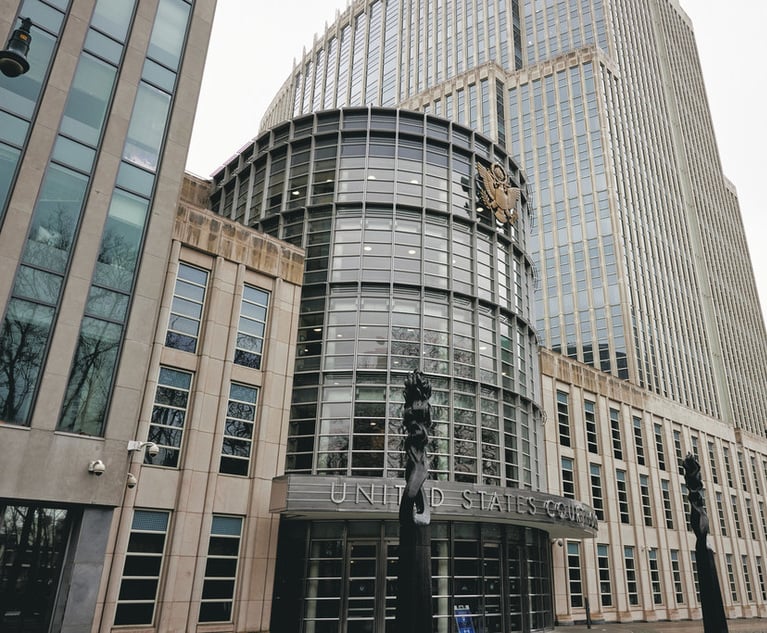California Courts May Not Apply New York Choice of Law Clauses
While parties have good reason to seek to achieve some level of certainty through the use of choice of law clauses in insurance policies, the 'Pitzer College' decision serves notice that California courts may disrupt such efforts. In their Corporate Insurance Law column, Howard B. Epstein and Theodore A. Keyes discuss the decision and takeaways.
November 27, 2019 at 12:00 PM
9 minute read
 Howard B. Epstein and Theodore A. Keyes
Howard B. Epstein and Theodore A. Keyes
Choice of law clauses in insurance policies are generally included in order to give the contracting parties certainty as to what state law will govern disputes under the policy. States that apply the principles of §187 of the Restatement (Second) of Conflict of Laws may interfere with this goal. Under §187, a choice of law clause will not govern where (1) the chosen state's law conflicts with a fundamental policy of the forum state; and (2) the forum state has a materially greater interest in resolving the issue in dispute than the chosen state. Restatement (Second) Conflict of Laws §187 (1971).
In Pitzer College v. Indian Harbor Insurance Co., 8 Cal.5th 93 (CA 2019), the Supreme Court of California, responding to questions certified by the U.S. District Court for the Ninth Circuit, held that California's notice-prejudice rule is a fundamental policy of the state. The Supreme Court did not decide whether California had a materially greater interest than New York in resolving the issue in dispute, returning the case to the Ninth Circuit for that determination. Nevertheless, the Supreme Court's decision provides California courts with a basis to refuse to apply choice of law clauses in insurance policies where the law of the chosen state conflicts with California law. While the issue presented in Pitzer College involved late notice, the ruling could apply more broadly depending on California courts' views of what constitutes a fundamental public policy and what constitutes a materially greater interest.
'Pitzer College v. Indian Harbor Insurance Co.' In Pitzer College, the insured college sought coverage from Indian Harbor under a pollution insurance policy for the costs of performing on-site soil remediation to address lead contaminated soils. The insured had first discovered darkened soils on campus in January 2011 at the site where a new dormitory was under construction. The college was under pressure to complete the dormitory prior to the start of the 2012 school year. The environmental consultants that Pitzer conferred with recommended on-site remediation through the use of a transportable treatment unit. Remediation work commenced in March 2011 and was completed about a month later at a total cost of approximately two million dollars.
The Indian Harbor policy provided coverage for "legal and remediation expenses resulting from pollution conditions discovered during the policy period from July 23, 2010 to July 23, 2011." The policy required the insured to provide notice "as soon as practicable" as a condition precedent to coverage. Specifically, the policy condition provided that, "in the event … any POLLUTION CONDITION is first discovered by the INSURED that results in LOSS or REMEDIATION EXPENSE … THE INSURED shall provide to the Company, whether orally or in writing, notice of the particulars with respect to the time, place and circumstances thereof … In the event of oral notice, the INSURED agrees to furnish to the Company a written report as soon as practicable." Pitzer College, 8 Cal.5th at 98-99.
In addition, the policy contained a consent provision requiring the insured, except in an emergency, to obtain Indian Harbor's written consent prior to incurring expenses, making payments or commencing remediation due to a pollution condition.
The policy also contained a choice of law clause providing that New York law would govern all matters arising under the policy. More specifically, the choice of law clause provided that "[a]ll matters arising hereunder including questions related to validity interpretation, performance and enforcement of this Policy shall be determined in accordance with the law and practice of the State of New York (notwithstanding New York's conflicts of law rules)." Id.
Pitzer did not obtain Indian Harbor's consent prior to commencing remediation operations. In fact, it did not notify Indian Harbor of the remediation until July 2011, approximately three months after remediation was completed and six months after the darkened soil was first identified.
Consequently, when presented with the claim, Indian Harbor denied coverage on the grounds that Pitzer had failed to provide notice as soon as practicable as required by the notice condition. Indian Harbor further denied coverage on the grounds that Pitzer had failed to obtain consent prior to commencing the remediation process.
The Ninth Circuit Certifies the Question. Pitzer College filed suit against Indian Harbor in the Los Angeles County Superior Court and Indian Harbor removed the case to federal court on the basis of diversity jurisdiction. The District Court granted Indian Harbor's motion for summary judgment, enforcing the choice of law clause. The District Court held that Pitzer had failed to provide timely notice and, under New York law, because the insurance policies were issued and delivered outside of New York, Indian Harbor was not required to demonstrate prejudice in order to deny coverage on late notice grounds. The District Court also held that Pitzer had violated the consent provisions of the policy. Pitzer College v. Indian Harbor Insurance Co., 2014 WL 12558276 (C.D. CA May 22, 2014).
On Pitzer College's appeal, the U.S. Court of Appeals for the Ninth Circuit certified two questions to the Supreme Court of California. The Ninth Circuit explained: "Resolution of this appeal turns on whether California's notice-prejudice rule is a fundamental public policy for the purpose of choice-of-law analysis. If the California Supreme Court determines that the notice-prejudice rule is fundamental, the appeal then turns on whether, in a first party policy like Pitzer's, a consent provision operates as a notice requirement subject to the notice-prejudice rule." 8 Cal.5th at 100.
The California Supreme Court Finds That the Notice Prejudice Is a Fundamental Public Policy. The California Supreme Court first looked to §187 of the Restatement (Second) of Conflicts of Law to address the choice of law issue. According to the Supreme Court, in order to avoid the application of New York law, Pitzer had to demonstrate that New York law is contrary to a fundamental California public policy and that California has a materially greater interest in determining the issue than New York.
It is undisputed that California and New York laws are contrary with respect to the late notice issue. If California law governed, the notice-prejudice rule would be applicable and Indian Harbor would have to demonstrate that it was prejudiced by the insured's late notice in order to deny coverage on those grounds. In contrast, while New York has adopted the notice prejudice rule in some circumstances, the rule was not applicable here because the policies were issued and delivered outside of New York.
The Supreme Court held that the notice-prejudice rule is a fundamental public policy of California. The Court explained that a rule can be determined to be a fundamental public policy when (1) the rule cannot be waived; (2) it protects against otherwise inequitable results; and (3) the rule promotes the public interest. Id. at 103-104. The court found that the notice-prejudice rule meets all three factors. The rule cannot be contractually waived, it protects insureds from inequitable results generated by uneven bargaining power and it promotes the public interest by preventing the public from bearing costs that would otherwise be covered under an insurance policy but for a technical basis for forfeiture.
Having found that the notice-prejudice rule is a fundamental public policy of California, the Supreme Court did not decide whether California also had a materially greater interest than New York in determining the coverage issue. Instead, because that was not one of the certified questions, the court left that issue for the Ninth Circuit to address.
Turning to the second certified question, the Supreme Court determined that California's notice prejudice rule applies to a consent provision in a first-party policy but not in a third-party policy (at least where the insurer has a duty to defend obligation). The court returned the case to the Ninth Circuit to determine whether the Indian Harbor policy should be considered a first-party or third-party policy for purposes of the consent issue. Id. at 105.
Following the Supreme Court decision, the Ninth Circuit remanded the case to the District Court to address the open issues concerning whether California has a materially greater interest than New York in resolving the dispute and whether the Indian Harbor policy should be considered a first-party or third-party policy. The Ninth Circuit noted that, if California law governs the dispute, and if the Indian Harbor policy is deemed a first-party policy, then the District Court will also need to address whether Indian Harbor suffered prejudice as a result of the Pitzer College's late notice and failure to obtain consent prior to performing the remediation. Pitzer College v. Indian Harbor Insurance Co., 779 Fed.Appx. 495 (9th Cir. 2019).
Looking Forward. In many insurance cases, a decision as to which state law governs can effectively resolve the case. State laws can differ over such key issues as late notice, insurability of punitive damages, interpretation of the pollution exclusion, allocation of loss for continuous injury or property damage, number of occurrences, as well as on many other issues. Consequently, while parties have good reason to seek to achieve some level of certainty through the use of choice of law clauses in insurance policies, the Pitzer College decision serves notice that California courts may disrupt such efforts.
Howard B. Epstein is a partner at Schulte Roth & Zabel. Theodore A. Keyes is special counsel at the firm.
This content has been archived. It is available through our partners, LexisNexis® and Bloomberg Law.
To view this content, please continue to their sites.
Not a Lexis Subscriber?
Subscribe Now
Not a Bloomberg Law Subscriber?
Subscribe Now
NOT FOR REPRINT
© 2025 ALM Global, LLC, All Rights Reserved. Request academic re-use from www.copyright.com. All other uses, submit a request to [email protected]. For more information visit Asset & Logo Licensing.
You Might Like
View All
Uber Files RICO Suit Against Plaintiff-Side Firms Alleging Fraudulent Injury Claims
3 minute read
Insurance Company Sues Over 180 Health Care Providers for Fraud Under RICO
3 minute read
New York Court of Appeals Tightens Pleading Standards Against Insurance Policyholder
7 minute read
Amid Growing Litigation Volume, Don't Expect UnitedHealthcare to Change Its Stripes After CEO's Killing
6 minute readLaw Firms Mentioned
Trending Stories
- 1States Accuse Trump of Thwarting Court's Funding Restoration Order
- 2Microsoft Becomes Latest Tech Company to Face Claims of Stealing Marketing Commissions From Influencers
- 3Coral Gables Attorney Busted for Stalking Lawyer
- 4Trump's DOJ Delays Releasing Jan. 6 FBI Agents List Under Consent Order
- 5Securities Report Says That 2024 Settlements Passed a Total of $5.2B
Who Got The Work
J. Brugh Lower of Gibbons has entered an appearance for industrial equipment supplier Devco Corporation in a pending trademark infringement lawsuit. The suit, accusing the defendant of selling knock-off Graco products, was filed Dec. 18 in New Jersey District Court by Rivkin Radler on behalf of Graco Inc. and Graco Minnesota. The case, assigned to U.S. District Judge Zahid N. Quraishi, is 3:24-cv-11294, Graco Inc. et al v. Devco Corporation.
Who Got The Work
Rebecca Maller-Stein and Kent A. Yalowitz of Arnold & Porter Kaye Scholer have entered their appearances for Hanaco Venture Capital and its executives, Lior Prosor and David Frankel, in a pending securities lawsuit. The action, filed on Dec. 24 in New York Southern District Court by Zell, Aron & Co. on behalf of Goldeneye Advisors, accuses the defendants of negligently and fraudulently managing the plaintiff's $1 million investment. The case, assigned to U.S. District Judge Vernon S. Broderick, is 1:24-cv-09918, Goldeneye Advisors, LLC v. Hanaco Venture Capital, Ltd. et al.
Who Got The Work
Attorneys from A&O Shearman has stepped in as defense counsel for Toronto-Dominion Bank and other defendants in a pending securities class action. The suit, filed Dec. 11 in New York Southern District Court by Bleichmar Fonti & Auld, accuses the defendants of concealing the bank's 'pervasive' deficiencies in regards to its compliance with the Bank Secrecy Act and the quality of its anti-money laundering controls. The case, assigned to U.S. District Judge Arun Subramanian, is 1:24-cv-09445, Gonzalez v. The Toronto-Dominion Bank et al.
Who Got The Work
Crown Castle International, a Pennsylvania company providing shared communications infrastructure, has turned to Luke D. Wolf of Gordon Rees Scully Mansukhani to fend off a pending breach-of-contract lawsuit. The court action, filed Nov. 25 in Michigan Eastern District Court by Hooper Hathaway PC on behalf of The Town Residences LLC, accuses Crown Castle of failing to transfer approximately $30,000 in utility payments from T-Mobile in breach of a roof-top lease and assignment agreement. The case, assigned to U.S. District Judge Susan K. Declercq, is 2:24-cv-13131, The Town Residences LLC v. T-Mobile US, Inc. et al.
Who Got The Work
Wilfred P. Coronato and Daniel M. Schwartz of McCarter & English have stepped in as defense counsel to Electrolux Home Products Inc. in a pending product liability lawsuit. The court action, filed Nov. 26 in New York Eastern District Court by Poulos Lopiccolo PC and Nagel Rice LLP on behalf of David Stern, alleges that the defendant's refrigerators’ drawers and shelving repeatedly break and fall apart within months after purchase. The case, assigned to U.S. District Judge Joan M. Azrack, is 2:24-cv-08204, Stern v. Electrolux Home Products, Inc.
Featured Firms
Law Offices of Gary Martin Hays & Associates, P.C.
(470) 294-1674
Law Offices of Mark E. Salomone
(857) 444-6468
Smith & Hassler
(713) 739-1250






